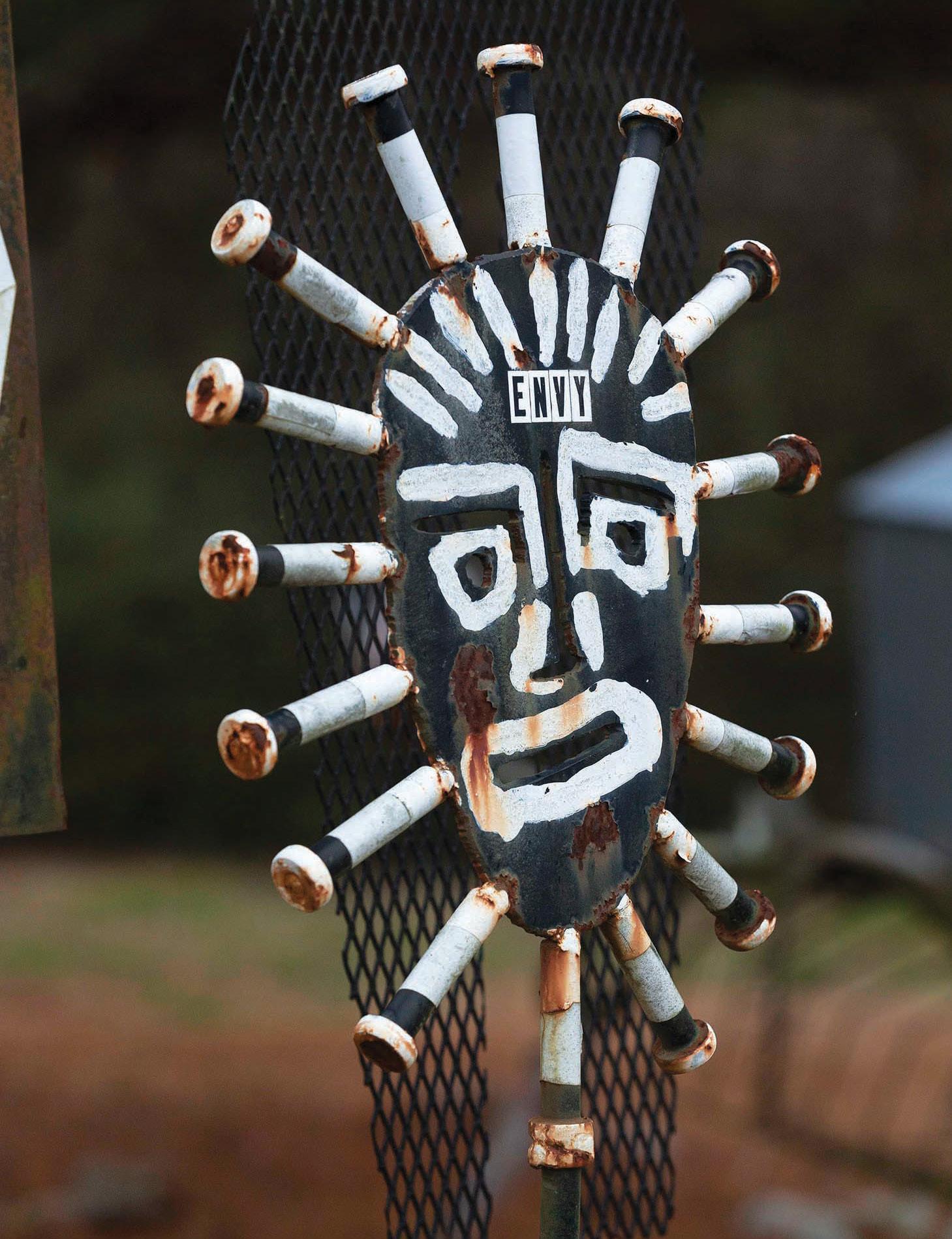
19 minute read
FEATURES
“Everything around us is made by an artist. The less we have of artists in this world, the more boring the world is going to be. ” – Tim Saguinsin, the Paper Cut Ninja art is everywhere
Life at home has offered a new appreciation for exploring the arts. Whether it’s virtual craft classes, public art exhibits or online concerts, those who seek shall find art all around. Starting right here.
Advertisement
ART BY BEN HARRIS
ART BY ANN MARIE AMICO


pscrap that Fuquay-Varina
sculptor makes
Photographed by Jonathan Fredin a statement
with metal
BBen Harris has always gone against the grain. A sculptor of whimsical metal forms, he is a one-of-a-kind artist, but not by his own admission. Born and raised on a farm in
Fuquay-Varina, Harris remembers even in his elementary years, as a student at the Fuquay-Varina Consolidated
School, not being able to keep pace.
“I wasn’t a real good student. I wasn’t learning fast enough and didn’t make the first grade,” he says.
Harris fed the farm’s chickens and cows as a child and later worked his family’s tobacco fields on a mule.
He still lives on that Fuquay farmland, now adorned with his large futuristic metal sculptures along the passing Piney
Grove-Wilbon Road.
With these rural North Carolina beginnings, Harris never expected to find himself living in Hollywood, selling sculptures to California art dealers. Written by Emily Uhland
A job in construction taught a teenage Harris how to weld, and he soon began to fashion life-sized objects out of the metal scraps.
“If I wasn’t welding, I was making something. No one identified it as art. The only person to accept what I did was my mother,” he says.
Harris moved to California as a young man and worked in a machine shop. During the 1984 Olympics in Los Angeles, Harris’s form of art began to take shape.
“There was a contest to do a sculpture about the Olympics. I did a sculpture in the back of the shop where I worked,” he says. “All my work was made out of scrap.”
A customer came into the shop and bought it immediately.
“He said, ‘I’ll give you $500.’ That’s more than I would make in a week,” Harris recalls.
IN A WORKSHOP BEHIND HIS HOME, BEN HARRIS FUSES SCRAPYARD REMNANTS INTO LIFE-SIZED SCULPTURES
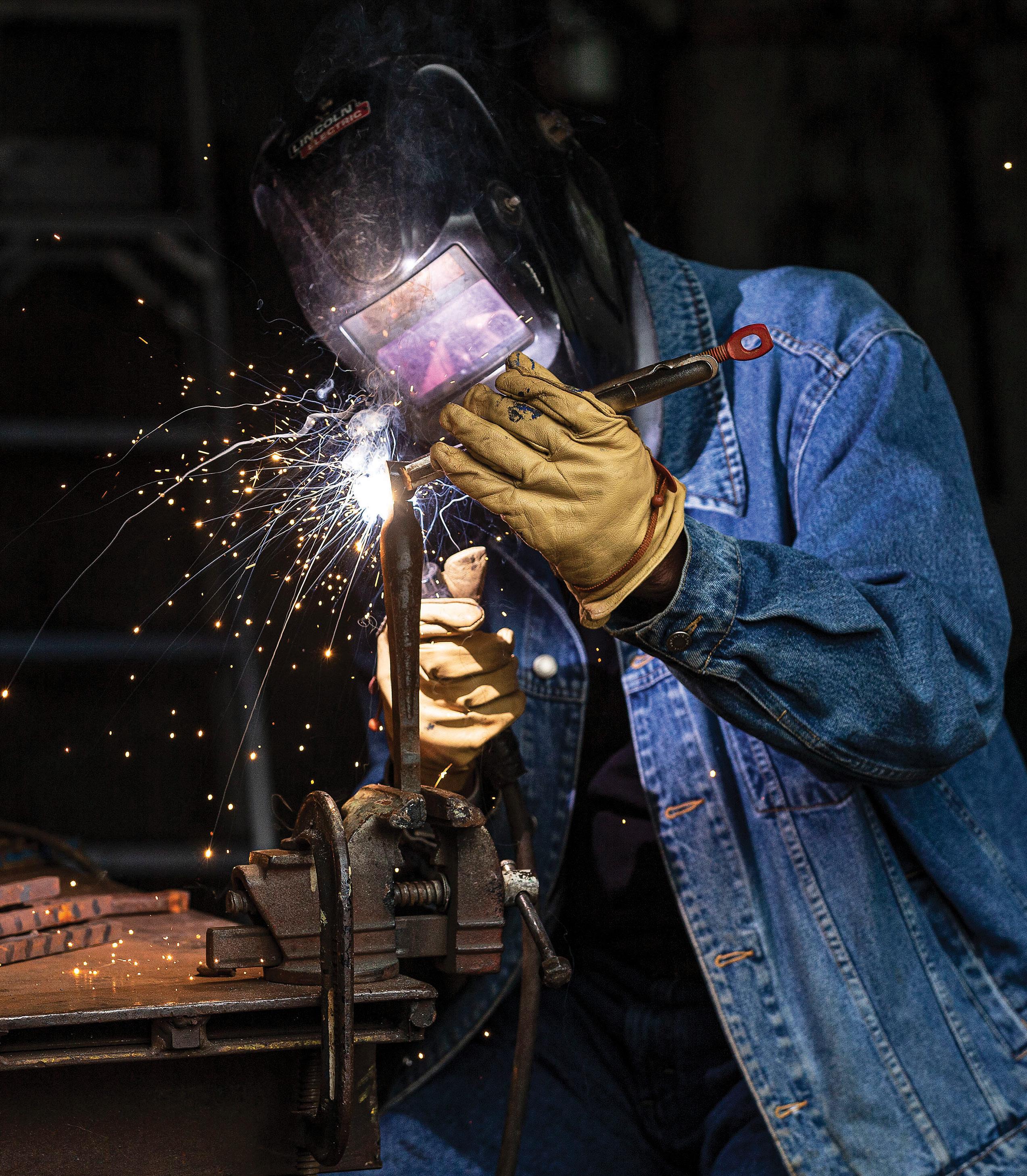
THE HEAD OF A DINOSAUR SCULPTURE.

THE DRESS OF THE “DANCING LADY” WAS MADE FROM A PROPANE TANK.

“LET THE METAL DO THE TALKING,” SHOWN HERE, IS AMONG HARRIS’ MOST RECENT WORK.

continued from page 22
After that, Harris caught the eye of an art dealer and started building more pieces to sell.
“I didn’t believe I was doing it. I was supposed to be a nobody. I thought creativity came from a university.
“I wanted to get a motorcycle, so I did sculptures to get the ball rolling,” he says with a chuckle.
Initially constructing animals, Harris quickly transitioned into human forms.
“I would go out to Venice Beach; there were all kinds of people there. ... They had all kinds of expressions. I started to see how people feel and how they act — you can put that in art.”
Harris’ sculptures can take up to a year to complete.
“I can’t see what it is at the beginning. I build it; then it expresses itself,” he says. “It’s hard to put into words.”
Eventually tiring of California culture — “Either I sell my soul to the art dealer or get out of Hollywood” — Harris made his way back to Fuquay-Varina.
The sculptures on display in front of his house initially elicited choruses of, “What in the world is that?”
“People hadn’t experienced anything like it,” Harris says. “Somebody has to show them.”
From a workshop behind his home, Harris combines materials salvaged from nearby junkyards, old machinery and spare parts.
“People come and give me scrap. One guy brought a propane tank and said, ‘I bet you can’t make anything out of this,’” says Harris.
Harris’ most recent work includes a series of figures including a priest (wearing a robe made out of the propane tank), preacher, police officer and an angel, entitled “Let the Metal Do the Talking.”
The sculptures have hinged arms and heads that twist, so they can be moved to interact in different ways.
“You don’t have to have a lot of materials if you have imagination,” he says.
Harris’ sculpture, Ghost Farmer, stands within the Fuquay-Varina Museums Complex, paying homage to the area’s agricultural past. At the center sits a wheel, salvaged from bygone farm equipment.
“I wish I knew what’s going on in his brain as he’s creating,” says Selina Williams, who claims Harris as her honorary

Better Together.















At Windsor Point, we know everything’s better when you’re close to those you love. With new residents relocating to Southern Wake they want their family and friends to move close and enjoy all the area has to o er.
Conveniently located in the heart of FuquayVarina, Windsor Point residents enjoy living close to shopping, recreational and cultural opportunities, as well as major medical centers.
Our community is custom-made for its residents who choose from a selection of cottages and apartments, exible dining plans and tness options. Housekeeping, maintenance, and transportation worries become a thing of the past.
Windsor Point is a Life Plan Community with Continuing Care providing Independent and Assisted Living, Memory Care and Skilled Nursing. Even if health needs keep couples apart, at Windsor Point our levels of care allow loved ones to remain close to one another.
For more information about joining us, call our Marketing Department at 919-552-4580 or visit us online at windsorpoint.com.









continued from page 24

father. The pair met about four years ago and have been close ever since.
“He didn’t have any children, and I didn’t have a father. I asked if he would be my dad,” Williams says.
“I don’t know how he does what he does.”
Williams is helping Harris brainstorm ways to make his sculptures mobile, and encouraging him to make tabletop versions for smaller collectors.
At 75 years strong, Harris is still creating, albeit at a slower pace than in his younger years.
“This is therapy for me,” he says. “I can pay for therapy, or I can weld.”
“I don’t call myself an artist. The art reveals itself to you. The plan don’t come from the brain; the brain should follow the plan.”
Harris’ sculptures can be viewed along Piney Grove-Wilbon Road between Academy Street and Wagstaff Road.
“SELINA,” NAMED FOR HARRIS’ HONORARY DAUGHTER.
THE LARGEST GALLERY OF HARRIS’ WORK IS IN HIS FRONT YARD, OFF PINEY-GROVE WILBON ROAD IN FUQUAY. NEWER WORKS, SHOWN BELOW, ARE PAINTED WITH A PAINT SPRAYER.

Mixed perspective
Written by Emily Uhland Photographed by Jonathan Fredin
M“Making is my motivation,” says Fuquay-Varina’s creative guru Ann Marie Amico. The process of creating forms the bridge that connects every aspect of Amico’s body of work, which includes mixed media artistry, brand design and community leadership. “I come from makers — everybody in my family got a different degree in college, but they’ve all come back to art as they’ve gotten older,” she says. Amico started her professional career as a special education teacher, before going back to school for commercial art and design when her two children were in elementary school. “As soon as I went, I just knew: Wow, this is for me,” she says. After graduating from Johnston County Community College (Wake Tech didn’t have a comparable art program at the time),
Amico started her own graphic design business.
While building that business, Amico continued to pursue fine arts education, taking a pivotal class in mixed media collage.
“I moved from realism to abstraction then, and I haven’t really looked back.”
Mixed media art combines a variety of materials — acrylic paint, paper, pastel, ink, natural stone, vintage objects — to create an image or form.
“I love contrast and color, and I think that’s why I like mixed media so much,” Amico says. “And my family is my base, so I want to do things that celebrate family and heritage and culture on the wall and on the body as well.”
For example, Amico creates abstract portraits using found objects and keepsakes that represent elements from a person’s life.
“When I (create a portrait) for the person, they know I’ve got these elements that are important to them that are worked into the piece.”
Amico also crafts mixed media jewelry that pairs natural and semi-precious stones with vintage pieces into one-of-akind wearable art.
“As an artist, you are trying to find how I can say this differently.”
“Being an abstract expressionist in a really small town, like 1% of the population is gonna find what you do interesting,” Amico admits. “It’s not unusual for me to feel like I am climbing uphill a little bit.”
MIXED MEDIA ARTIST AND BRAND DESIGNER ANN MARIE AMICO, OF FUQUAY-VARINA
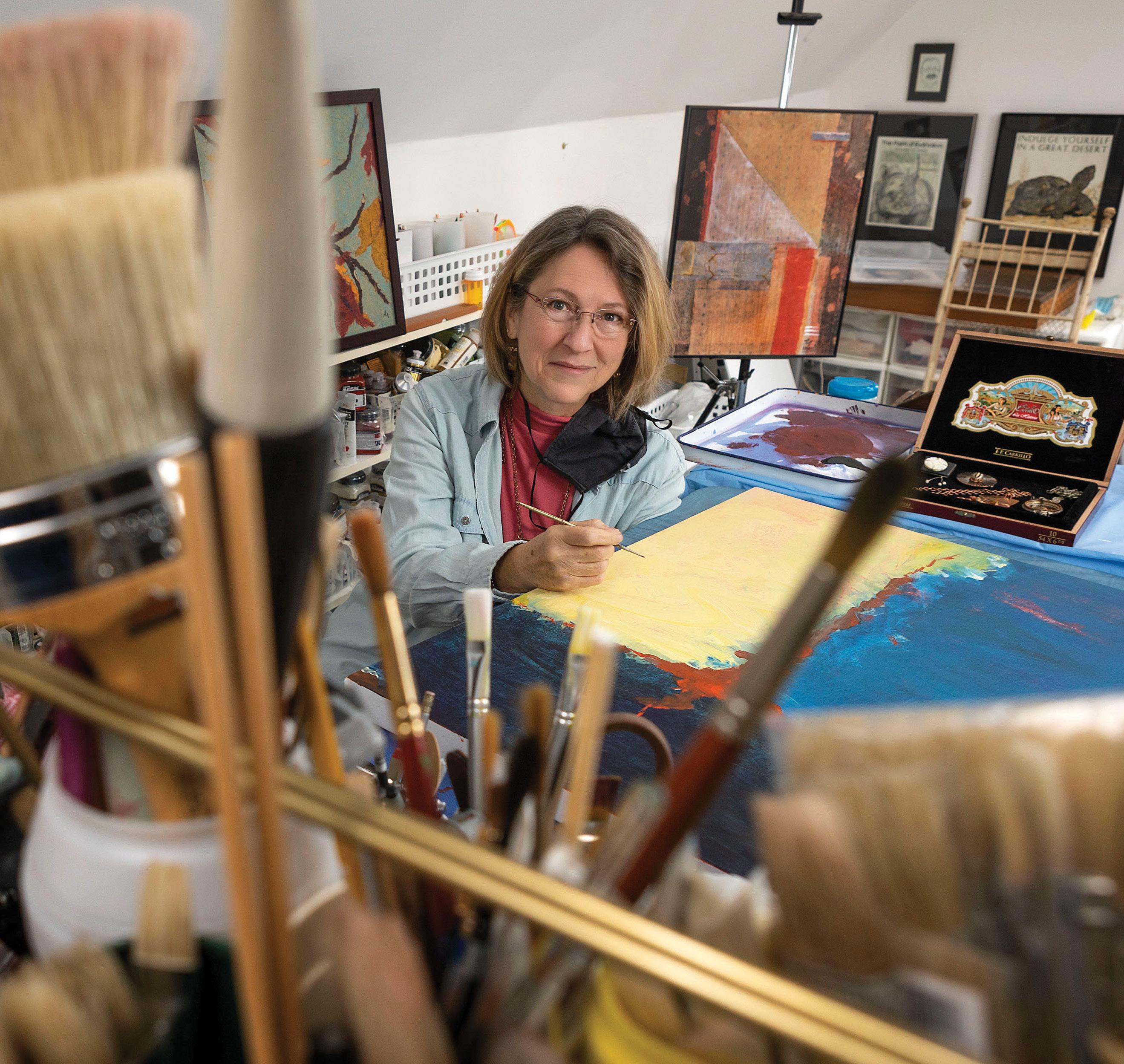
“communities that support artists are vibrant and sustainable, because they are open to new ideas, and They celebrate people that are diverse. ” – Ann Marie Amico
MIXED MEDIA ART USES VARIED MATERIALS, SUCH AS PAINT, PAPER AND INK, TO CREATE THE FINISHED WORK.
continued from page 28

The early days of Amico’s design business felt similar.
“I learned everything you shouldn’t do,” she says. “In a small town, people didn’t really know what to do with a graphic designer.”
Professional development became vital to growing Amico Brand Design, and joining organizations like the Council for Entrepreneurial Development, the Women Business Owners Network in Cary, the Raleigh Professional Women’s Forum and the FuquayVarina Chamber of Commerce proved to be hugely valuable.
“I loved my design life, because I met so many different people. No two days were the same.”
On the board of the Fuquay-Varina Chamber of Commerce, Amico witnessed the connection between economic development and community building, which propelled her to work as a brand designer with municipal clients such as Angier, Roxboro and Harnett County.
“I have an affinity for small towns and the work ethic in agricultural communities. I like ... helping people find their points of connection. I think that helping people talk to each other builds a stronger base that can move the community forward,” Amico says.
“The thing that, for me, connects everything that I enjoy is problem solving. If you are a designer, either you’re figuring out how to create a symbol that reflects a company’s brand, or you are trying to fit 150 words into a three-inch box. You are always trying to figure out how to solve a problem.
“With design of jewelry or art, I’m still trying for that. How I can say something with a clean look, or how I can reflect something of somebody’s personality with these stones or this piece of ephemera from their past?”
While Amico’s artistic career has ebbed and flowed as her life as a business-owner, wife, mother, and now grandmother, has evolved, the artistic principles learned early on create a connection throughout all of her work.
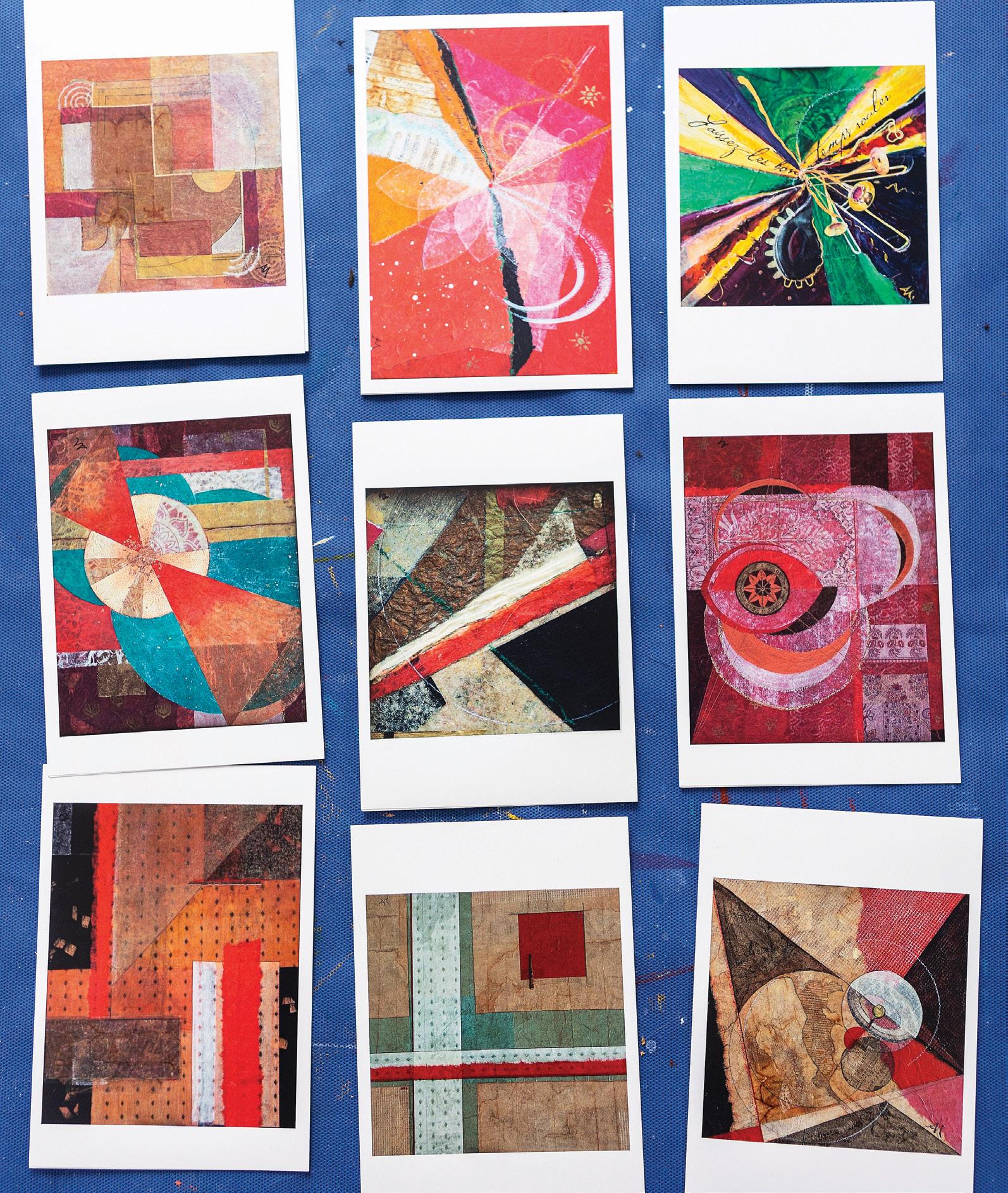
“In design, line and form are really important, as are rhythm and contrast. All those kinds of things that you learn to be a designer are really important. And they show up in the same way you lead your eye around a painting or the same way you make a rhythm in a necklace, so it all hangs together,” she says.
A resident of Fuquay-Varina for 33 years, Amico has experienced the ebbs and flows of the town’s growth as well.
“The people that are involved in small town development are really interesting and hard working, so that’s where I got hooked on economic development. … We came to Fuquay when it was struggling back in 1987, and to watch all the effort that has been put into helping downtown thrive, and watching what it’s done for the whole community — that’s why you do it.”
Fostering the arts is vital for growing communities, like Fuquay-Varina, Amico says, not merely for the success of creative individuals, but for the health of the town as a whole.
“Communities that support artists are vibrant and sustainable, because they are open to new ideas, and they celebrate people that are diverse. … The arts are a really effective way of
AMICO COMBINES NATURAL STONES AND VINTAGE OBJECTS INTO ONE-OF-A-

KIND PIECES OF JEWELRY.
having people of different backgrounds communicate with each other and find points of connection.
“If you think of arts as a bigger thing than just music or dance or painting; if you think of it as a community of makers, you’ve created a place that people want to come and enjoy.”
annmarieamico.com amicobranddesign.com


THE PAPER CUT NINJA, TIM SAGUINSIN, NIMBLY TRANSITIONS BETWEEN HIS ROLES AS AN ARTIST, ATHLETE AND BUSINESS OWNER.

the art of perseverance

Meet the Paper Cut Ninja
Written by Emily Uhland Photographed by Jonathan Fredin
TThe term “ninja” has many associations in present day vocabulary.
There’s the stealthy Japanese warrior figure. Or a person with exceptional skills in a particular area, such as a culinary ninja. And an obstacle-surmounting, high-flying athlete, like those competing on “American Ninja Warrior.”
Going back to the word’s origin, however, ninja signifies perseverance, which very aptly describes Tim Saguinsin, the Paper Cut Ninja, and his journey as an artist, small business owner and athlete.
Exhibiting a strong affinity for the arts early on, Saguinsin attended an arts-focused high school and then the Maryland Institute College of Art in Baltimore, where he concentrated on painting and sculpture.
“I was all set to become the greatest artist ever until I saw how expensive my tuition was, and I had to figure out how I was going to pay for everything,” Saguinsin says. “So I converted the knowledge and talents I had and started to learn how to use a computer.” Pivot no. 1.
Thus began his career as a computer graphic artist and animator, producing educational materials for children.
“I turn really complex lessons into something that a kid can easily digest,” he says.
Work that took him to London and back, eventually landing in Cary, after living eight years in Holly Springs, with his wife and two sons.
Noticing the popularity of paper cutting machines like the Cricut — thanks, in part, to the family’s many crafty friends — Saguinsin experienced a light-bulb moment.
“When I realized that I could use the files that I create on the computer in digital form and turn it into paper, that was it.
“It was like being back in art school again. I was exploring all kinds of different things with it. I started developing my voice,” he says. Pivot no. 2.
That voice turned into a business called Paper Chop Shop, producing vibrant and punchy three-dimensional paper sculptures and wall art. Everything from silhouettes, city skylines, animals and illustrated characters, brought to life through layer upon layer of colorful paper and creative, intricate cuts.
“There are layers of meaning, and as an

“COMING HOME TO HOLLY SPRINGS,” DEPICTS SAGUINSIN’S FAMILY EN ROUTE THROUGH MANY TOWN LANDMARKS.
continued from page 33
artist you have to decide how deep to go,” he says.
Saguinsin is head chopper, a role he assumes on nights and weekends, after his day job as an animator is complete.
Each project begins with an original illustration on the computer, and then is cut out on paper in careful detail.
“Nothing takes less than five hours. Most of the projects take anywhere from eight to 10 hours,” Saguinsin says.
One locally noteworthy piece, called “Coming Home to Holly Springs,” has recently been on display at Our Moments in Time in Holly Springs.
FAMILY EXPERIENCES, CULTURAL HISTORY AND NINJA PORTRAITS ALL FIND THEIR WAY INTO SAGUINSIN’S WORK.
The work features a playful map of various Holly Springs buildings, such as the cultural center and Bass Lake conference center, which Saguinsin created for an art festival as a board member of the Holly Springs Arts Council.
“The Arts Council was all about trying to push the arts and make sure the arts were never going to be forgotten. I always want to identify with Holly Springs; give where you are from the notoriety that it deserves,” he says.
Saguinsin’s work received a new level of notoriety when he debuted on the television show “American Ninja Warrior” as the Paper Cut Ninja, selected for a three-anda-half minute hometown highlight out of 70,000 initial applicants.
“For my submission video, I talked about being the Paper Cut Ninja. I cut all the ninjas out that are on the show, and that was my schtick for getting on the show,” he says.
Saguinsin’s episode aired during the summer of 2019, and since then he has received multiple commissions for portraits of other ninjas.
“I was incredibly honored and privileged to have something on the show,” he says. “I want to get back on (“American Ninja Warrior”), because I want to do better than I did last time. I only got to the second obstacle. The water was cold. I want to be able to do it so I don’t get wet.”
Saguinsin fell in love with ninja training after completing a Spartan race with his wife and friends.
“That was my turning point. This is what I want to be doing.”
So, he jumped head first into promoting the sport by opening Warrior Tech training facilities in Morrisville and, later, North Raleigh. Pivot no. 3.
“I realized there were no places to train for Spartan races, and I wanted to have a business where you could train for it.



“It was like being back in art school again. I was exploring all kinds of different things with it. I started developing my voice. ” – Tim Saguinsin, Paper Cut Ninja MB
“Four days after I opened the gym, I tore my achilles tendon doing the warp wall. … Two years later on the exact day that I tore my achilles tendon, I stepped on the course of ‘Ninja Warrior’ and was allowed to run that course,” he says. Like I said: perseverance.
“It’s all about supporting one another, fighting through whatever problems and obstacles are in front of you,” he says of ninja training.
The Warrior Tech facilities have been hit hard by Covid-19, operating at low attendance for their usually popular trackout camps, group classes and birthday parties. Still, Saguinsin’s enthusiasm remains.
“It’s one of the coolest communities you’ve ever been to. … I want the sport to grow, and want everyone to overcome each obstacle.”
In the meantime, Saguinsin continues to develop his style of paper art, some of which can be seen at the Morrisville location of Warrior Tech OCR.
“For me, I’m trying to find a way to get back to my roots of being an artist. I like doing commissions, it’s fun. But I really want to get back to being free to create whatever I want to create … work that speaks to me.”
PAPER CHOP SHOP
PAPERCHOPSHOP.COM Jean Guevarra You, DDS Board Certified Pediatric Dentist

Now Accepting New Patients
Early Morning, Late Afternoon & Friday Appointments Available In-Network with Most Insurance Carriers In-House Membership Plan Available Video Games, T.V.s, Photo Booth, Wi-Fi, Phone Charging Station, Coffee Bar & More
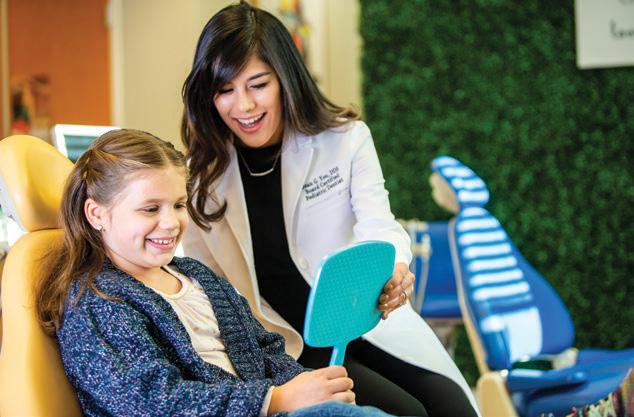
“...Dr. You was amazing. She was so kind, patient and down-to-earth, and that not only put my son at ease, but me as well. We’re thrilled to have found such a warm, welcoming practice and we look forward to being patients for many years to come!” -Brendan S. ⭐ ⭐ ⭐ ⭐ ⭐ “Dr. You is so knowledgeable, kind and patient... Highly recommend!” -Ayub A. ⭐ ⭐ ⭐ ⭐ ⭐ I can not say enough good things about Dr. Jean You! She and her staff were extremely welcoming to my son and me at our recent visit. Dr. Jean was amazing with my son – very calm and comforting. She explained everything she was gong to do before doing anything. You can tell that Dr. Jean has a true passion for this profession and loves what she does. We had an awesome experience at Little Tooth Co. and are so appreciative of the care that we received. If you are looking for a wonderful dentist to take your child to, you definitely need to become a patient of this practice!” -Erin D. ⭐ ⭐ ⭐ ⭐ ⭐

Tel 919-303-2873 www.littletoothco.com info@littletoothco.com 504 W. Williams St., Apex 27502




